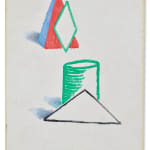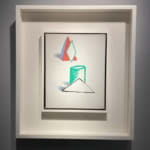David Hockney BRITISH, b. 1937
Study for Simplified Faces (Homage to Picasso), 1974
Oil on canvas
24.1 x 19.1 cm
9.49 x 7.52 in
9.49 x 7.52 in
With outstanding provenance, Study for Simplified Faces was acquired via Christies from the collection of Hockney's friend and collaborator Cavan Butler. Butler came to know Hockney through his role as...
With outstanding provenance, Study for Simplified Faces was acquired via Christies from the collection of Hockney's friend and collaborator Cavan Butler. Butler came to know Hockney through his role as Production Manager at Petersburg Press during the 1970s and early 1980s, and later worked for the artist’s UK office traDHart between 1983 and 1998. A typographic designer by trade, Butler was originally employed by Paul Cornwall-Jones—the founder of Petersburg Press—who published Hockney’s prints. The office was based on Portobello Road, near to the artist’s London studio on Powis Terrace: Butler recalls meeting Hockney for the first time when he went to deliver flight tickets to his home, and was invited up to the studio on the top floor. Over the following years Butler worked directly with the artist on the design and production of his exhibition posters, notably for shows at the Tate Gallery in 1980 and the Ashmolean Museum, Oxford in 1981, as well as the iconic poster for Hockney’s triple bill Parade at the Metropolitan Opera, New York that same year. This work was gifted to Butler by the artist, and remained in his personal collection until 2023.
Butler describes Study for Simplified Faces as evidence of Hockney’s enduring dialogue with Picasso. The Spaniard had been a major source of inspiration to Hockney since his student days, when he famously returned to Picasso’s 1960 retrospective at the Tate Gallery eight times. The artist’s death in 1973 had prompted a number of acts of homage on Hockney’s part, including The Student: Homage to Picasso and Artist and Model, both created that year. While living in Paris between 1973 and 1975, Hockney worked with Aldo Crommelynk, with whom Picasso had produced his prints during his last two decades. The two spent time discussing his life and work. For Butler, Study for Simplified Faces reflects not only the influence of Cubism during this period in Hockney’s career, but also captures the artist’s transition back to oil paint after a number of years working in acrylic. Hockney would later go on to explore the full implications of Cubist logic in his photo-collages, portraits and landscapes of the 1980s, cleaving to the idea we experience reality as a set of simultaneous, overlapping snapshots.
Butler describes Study for Simplified Faces as evidence of Hockney’s enduring dialogue with Picasso. The Spaniard had been a major source of inspiration to Hockney since his student days, when he famously returned to Picasso’s 1960 retrospective at the Tate Gallery eight times. The artist’s death in 1973 had prompted a number of acts of homage on Hockney’s part, including The Student: Homage to Picasso and Artist and Model, both created that year. While living in Paris between 1973 and 1975, Hockney worked with Aldo Crommelynk, with whom Picasso had produced his prints during his last two decades. The two spent time discussing his life and work. For Butler, Study for Simplified Faces reflects not only the influence of Cubism during this period in Hockney’s career, but also captures the artist’s transition back to oil paint after a number of years working in acrylic. Hockney would later go on to explore the full implications of Cubist logic in his photo-collages, portraits and landscapes of the 1980s, cleaving to the idea we experience reality as a set of simultaneous, overlapping snapshots.



